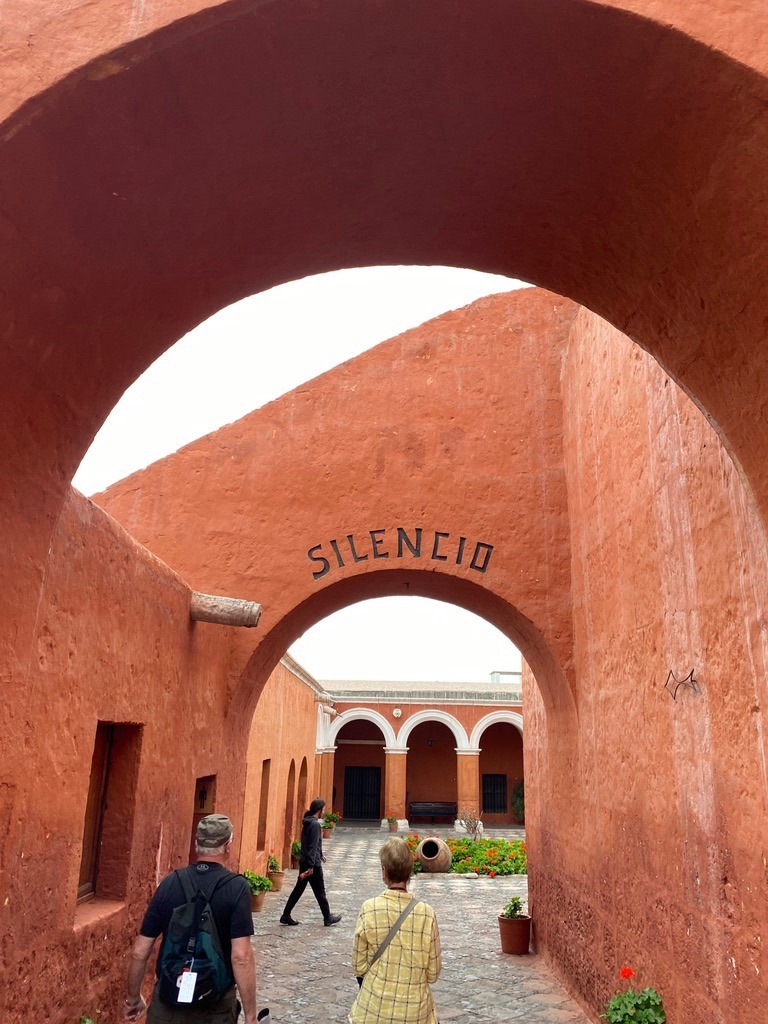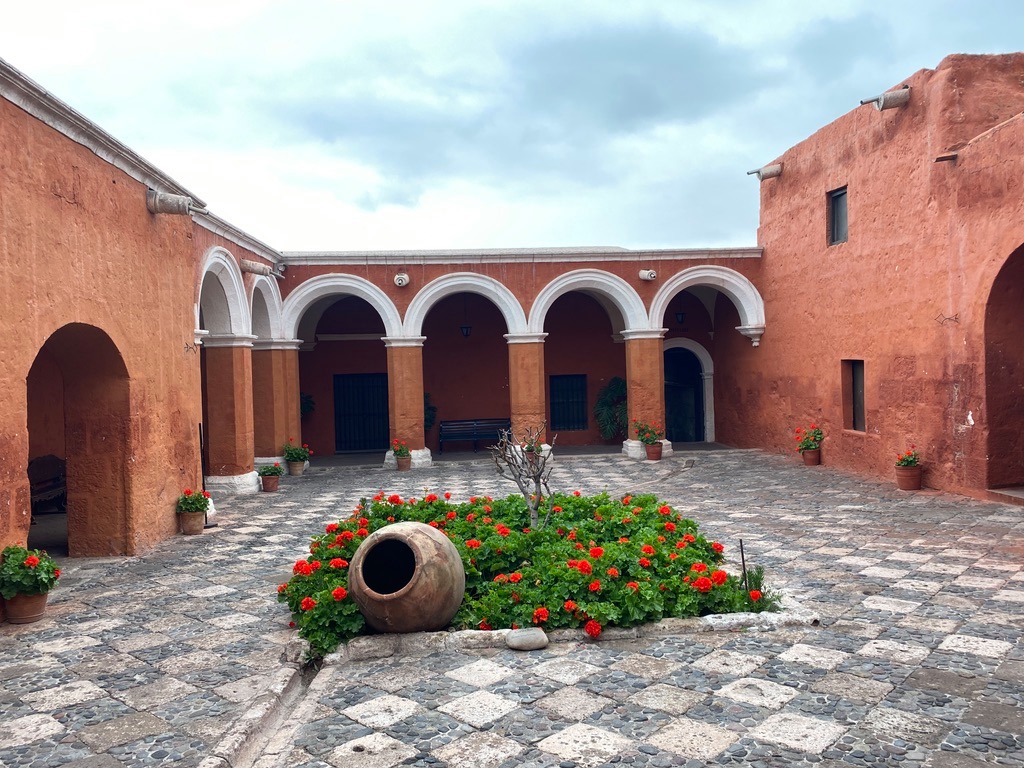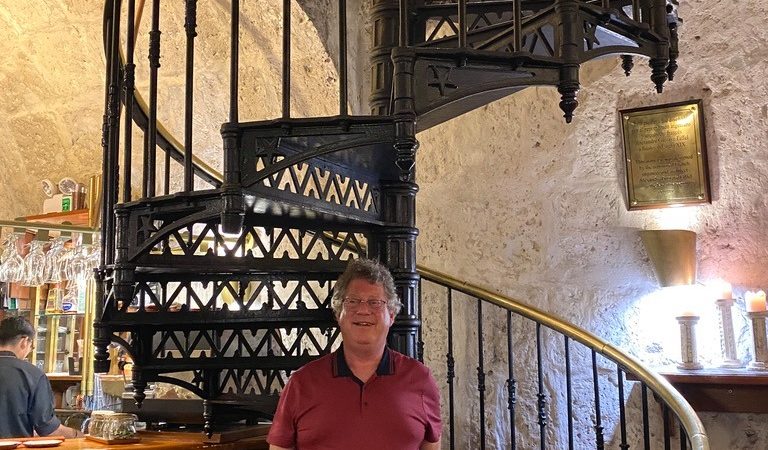Today we flew to Arequipa, The White City. Gets its name from the white volcanic rock used to construct the city. The Convent of Santa Catalina, is virtually a city within the city. Nuns lived in houses, ate, prayed, did laundry all without ever leaving the place which is right in the middle of the Arequipa. I wanted to go ChiCha – Gaston Acurio’s restaurant, but it was closed for renovations. Instead I went to ZigZag – whose spiral staircase was designed by Gustave Eiffel. Finally we went to the museum that looks after the Virgin of the Sun. She was a young girl, taken up to be sacrificed to the mountain god.
The flight was about an hour. We had a new Peruvian guide waiting for us at the airport. Senior Discovery Tours contracts a Peruvian Tourist company to provide the local guides. The guides are from the area so they really know their stuff.
Our hotel was Hotel Piru Wasi. It was the former government mint and an excellent example of the white volcanic rock. It was my first close up view of the White City. The rock is soft, yet strong – like pumice. It is easily carved – the lion statue for example. We would see lots of carved walls throughout the city. We got in around lunch time so we just checked in and then met to go to the restaurant for lunch.


We went for lunch at Zingaro. This time we did not have to order in advance – we could have whatever we wanted from the menu. We were the only patrons in the restaurant because it was early. In high altitudes, you have a large lunch and small dinner. Ceviche is the national dish – raw fish in citrus. Here is a traditional ceviche to the left and chili pepper sauce on the right.

For the main course I ordered deep fried cuy – in the Quecha language. In English – Guinea Pig. Yes, the Andes natives raise Guinea Pigs as a food source. I had seen signs from the bus for guinea pig farms. Our guide explained that families raise them for both food and as gifts. I spoke with the chef and he assured me it was a “farm to fork” arrangement that the restaurant had with a farm. Yes, it tastes like chicken.


We walked to the convent. At the top of this building you can see the volcanic brick used in construction. And the Montreal Art Cafe.

The entrance to the Monastery of Santa Catalina de Siena. Blessed Ann of Santa Catalina. She performed a miracle after she died. She needs one more to become a saint – Peru’s first.

You can see the layout of the convent. Built in 1759, at one point it housed 400 people – nuns and their servants. Wealthy families would donate to expand the convent adding rooms for their family to use.

They covered part of the area in red ochre. This was for the beginning nuns. As they became more experienced they would move to the blue area.


Travel tip, do not lean against red ochre pillars while wearing white pants.

This area was where they communicated with the outside world. Family could come through a door from outside and talk with then through the wooden slats. There is also a turntable where goods where passed through. Later, there was a “market” courtyard where they could trade items.

This is the room of a novitiate. They would spend 12 years here.

The bed was below an arch. It would be the safest place in the event of an earthquake.

After 12 years they would move into the blue area. Because the complex was built over a long period of time, there is a mixture of styles seen in the architecture. Thrice hit by earthquakes, it is now maintained through the World Monument Fund.

Families could pay 2 or 3 thousand silver pieces to have a home constructed. Plus 2,000 a year for support. The stairs on the right were for the servant’s bedroom. However, in 1871, according to Wikipedia, Pope Pius IX sent sister Cadena to reform the monastery. She freed the servants and slaves.
Sometimes there would be 2 or 3 nuns in one house. An oven for cooking for 3.

This was a 3 bedroom house. They would have gettogethers where they would play music and sing. This did change when a pope decreed they need to be communal.

Being communal meant doing everyone’s laundry. The water in the trough at the top would be diverted into the tub. Clothes were washed then the plug taken out for draining. This was our guide provided by the monastery.

We headed back to the central square. It has the church in the background. The other 3 sides all have the same architecture which contain shops, banks and restaurants.


Our tour guide took us to the Museum of Andean Sanctuaries. We were taken on a private tour by the museum’s guide. Photos were not allowed. The main artifact is a 12 year old mummified girl. Her name is Juanita. She trekked up a mountain with the Inca priests. She was drugged then placed in this position. She was killed with a blow to the back of the head. Discovered in 1995 by John Reinhardt, the body frozen by the snows. National Geographic did a special edition. Time magazine cited her as one of the top ten discoveries. There has since been a few of these sacrificed boys and girls found.

We were on our own for dinner. I had made a reservation at Zig Zag restaurant. I walked by the church at night.

The hostess at Zig Zag place me at a table at the front so I could watch the people. The dish is alpaca – one of the healthiest meats because of the low cholesteral. Dijon mustard sauce. Causa – which is a mashed potato square. This one was filled with asparagus. Keeping in mind the light dinner in high altitudes, I had ordered this from the appetizer menu.

Supposedly, this spiral staircase was designed by Gustave Eiffel of the Eiffel Tower fame. As I had seen another building in Lima that was designed by Eiffel, it was most likely true.

